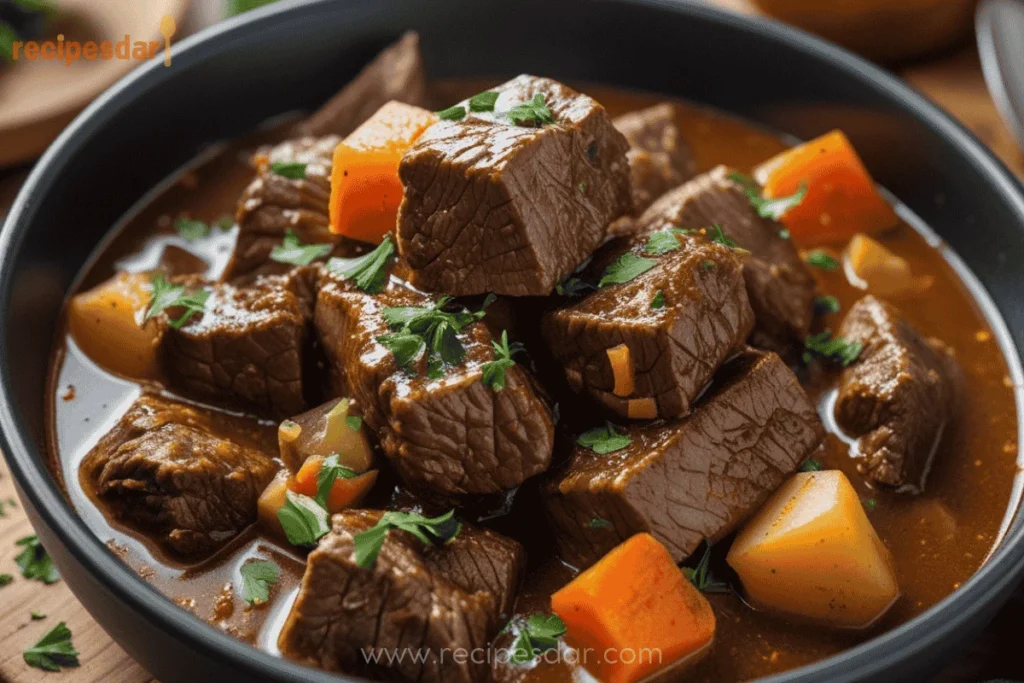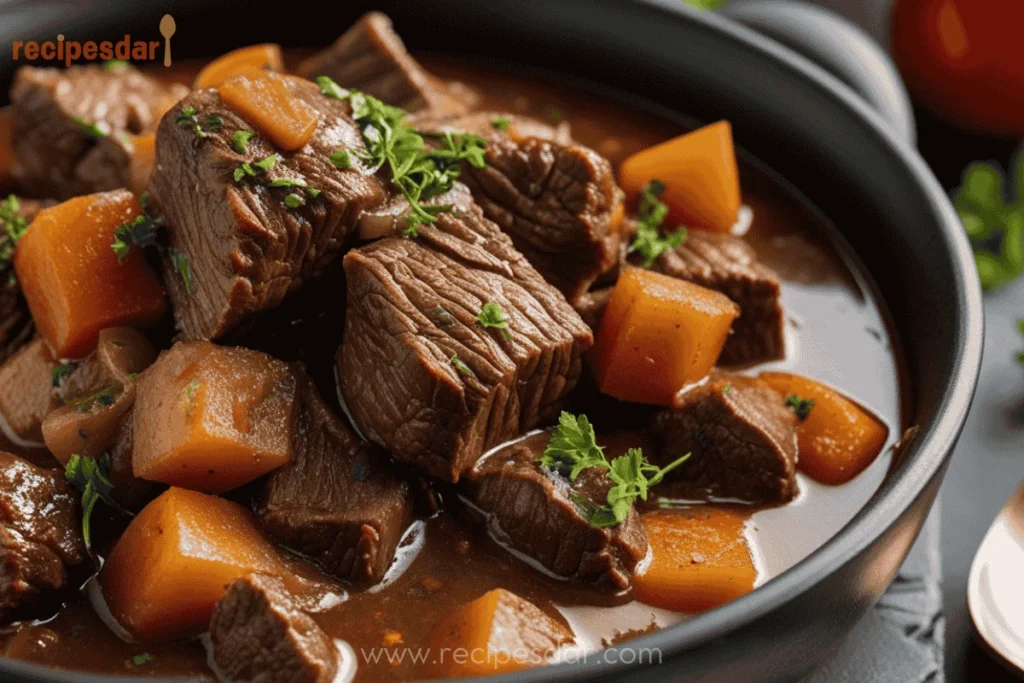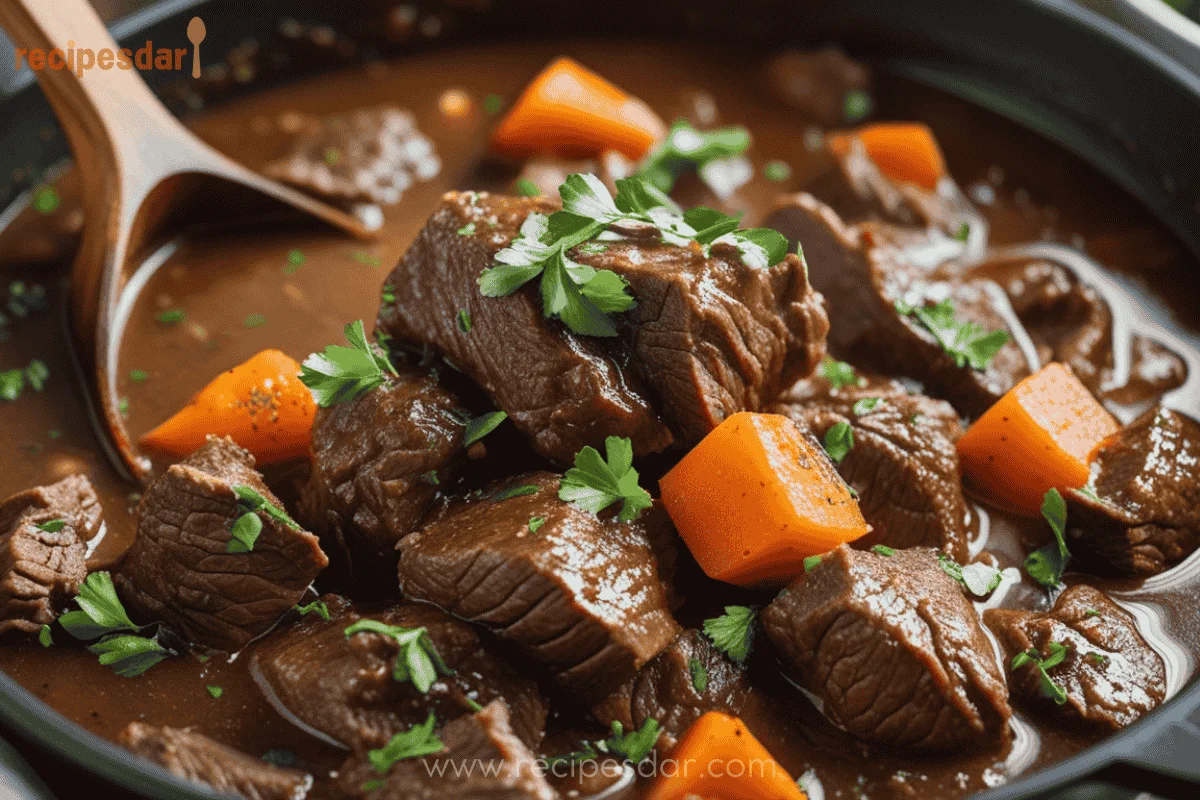Introduction to Beef Stew
Beef stew is one of the most cherished dishes in culinary history, transcending cultures and generations. This hearty meal dates back centuries, with roots in medieval Europe when slow-cooking was a practical way to tenderize tough cuts of meat while infusing them with rich flavors. Over time, beef stew became a staple in households worldwide, each region adding its own unique twist to the recipe. From French-inspired boeuf bourguignon to Hungarian goulash, beef stew reflects the adaptability of simple ingredients to diverse culinary traditions.
The dish’s enduring popularity lies in its comforting nature. With tender chunks of beef, flavorful vegetables, and a savory broth, beef stew is the epitome of a one-pot meal that nourishes the body and soul. Its versatility makes it suitable for every occasion—whether it’s a weekday dinner or a festive gathering. Slow cooking allows the flavors to meld together, creating a depth and richness that’s hard to replicate in other dishes.
This guide will teach you everything you need to know about crafting the perfect beef stew. From selecting the right cuts of beef to mastering techniques, you’ll find the secrets to a dish that’s both wholesome and delicious. Explore Perfect Beef Cuts for Stews for expert advice on choosing the best meat for your recipe.

Why Beef Stew Is a Beloved Classic
The magic of beef stew lies in its simplicity and versatility. It’s a one-pot meal packed with nutrients, making it an ideal choice for both casual meals and special gatherings. Slow cooking allows the flavors to meld beautifully, creating a dish that warms you inside and out. To discover creative twists, check out International Stew Variations and bring global flavors to your table.
Beyond its taste, beef stew adapts to various cooking methods and dietary needs, from stovetop simmering to vegetarian versions. It’s a culinary canvas for your creativity.
Essential Ingredients for the Best Beef Stew
To achieve the perfect beef stew, start with high-quality ingredients:
1. Beef Cuts
- Opt for well-marbled cuts like chuck roast, brisket, or short ribs.
- These cuts tenderize beautifully during slow cooking, absorbing the rich flavors of the stew.
2. Root Vegetables
- Potatoes, carrots, and parsnips provide heartiness and absorb the stew’s savory broth.
- Choose waxy potatoes to hold their shape during cooking.
3. Alliums
- Onions, garlic, and shallots create a savory base.
- Their natural sweetness deepens the stew’s flavor as they cook.
4. Liquid Base
- Use beef stock for a robust flavor, enhanced with red wine or water for balance.
- For a tangy twist, consider adding a splash of Worcestershire sauce.
5. Herbs and Spices
- Classic choices include thyme, bay leaves, and parsley.
- Black pepper and smoked paprika add warmth and depth.
Preparing Your Beef Stew for Success
Preparation is critical for crafting the perfect . Follow these steps:
- Pat the Beef Dry: Ensures even browning for a richer flavor.
- Chop Vegetables Consistently: Uniform pieces cook evenly, creating a balanced texture.
- Organize Your Ingredients: Prepping ahead saves time during cooking.
Cooking Techniques for the Perfect Beef Stew
1. Stovetop Method for Classic Beef Stew
- Heat oil in a heavy-bottomed pot and sear the beef in batches to avoid overcrowding.
- Remove the beef, then sauté onions and garlic until fragrant.
- Deglaze the pot with wine or stock, scraping up browned bits.
- Add beef, vegetables, herbs, and remaining liquid. Simmer for 1.5–2 hours.
2. Slow Cooker Method for Easy Beef Stew
- Sear the beef, then transfer it to the slow cooker.
- Layer with vegetables, herbs, and stock. Cook on low for 6–8 hours or high for 4–5 hours.
3. Pressure Cooker Method for Quick Beef Stew
- Sear the beef, add all ingredients, and cook under pressure for 30–40 minutes.
- Let the pressure release naturally to retain tenderness.
For detailed cooking tips, refer to Essential Cooking Techniques for Stews.

Enhancing the Flavor of Your Beef Stew
Even the simplest can shine with a few flavor-boosting tricks:
- Tomato Paste: Adds a tangy, rich base.
- Worcestershire Sauce: Deepens the umami flavor.
- Balsamic Vinegar: Balances the broth with a touch of acidity.
Creative Variations for Beef Stew
Take your beef stew to the next level with these global variations:
- Hungarian Goulash: Add paprika and caraway seeds for a smoky, spicy twist.
- Irish Stew: Incorporate stout beer to create a malty, rich broth.
- Vegetarian Stew: Replace beef with mushrooms or lentils for a plant-based alternative.
FAQs About Beef Stew
What is the secret to good stew?
The secret to a good beef stew lies in building layers of flavor. Start by searing the beef for a caramelized crust, deglaze the pot to capture browned bits, and add fresh aromatics like garlic, onions, and herbs. Slow cooking allows the flavors to meld together for a rich and hearty dish.
What to add to beef stew to make it amazing?
Enhance your beef stew with these additions:
- Red Wine: Adds depth and complexity.
- Worcestershire Sauce: Boosts umami flavors.
- Fresh Herbs: Thyme, rosemary, and parsley for aroma.
- Balsamic Vinegar: Adds brightness and balances richness.
What cut of beef is best for a stew?
Cuts like chuck roast, brisket, or short ribs are ideal for beef stew. These cuts have marbling and connective tissue that break down during slow cooking, resulting in tender and flavorful meat.
What is the one ingredient upgrade for better beef stew?
Adding miso paste or soy sauce is a game-changer. These umami-packed ingredients enhance the depth of flavor without overpowering the dish.
What not to put in a stew?
Avoid these ingredients:
- Delicate Vegetables: Spinach or zucchini will turn mushy.
- Overpowering Spices: Too much cumin or cloves can dominate the flavor.
- Uncooked Flour: Adds a raw taste unless properly incorporated.
What if I forgot tomato paste in beef stew?
If you forgot tomato paste, substitute with alternatives like ketchup, a small amount of tomato sauce, or even finely diced tomatoes. These options add acidity and richness similar to tomato paste.
What is the secret ingredient in a stew?
The secret ingredient in many great stews is dark chocolate or cocoa powder. A small amount adds complexity and richness to the flavor without tasting like chocolate.
Can I use ketchup instead of tomato paste in stew?
Yes, ketchup can be used as a substitute for tomato paste in beef stew. However, it is sweeter, so adjust by reducing other sweet ingredients or adding a touch of vinegar to balance the flavors.
What vegetables are good in beef stew?
Root vegetables like potatoes, carrots, and parsnips are excellent for beef stew. Other options include celery, turnips, and peas for texture and flavor variety. Seasonal vegetables like butternut squash can also add a unique twist.
Pairing Ideas for Your Beef Stew
- Crusty Bread: Perfect for soaking up the rich broth.
- Mashed Potatoes or Rice: Adds a comforting, hearty side.
- Light Salads: Balances the richness with a refreshing contrast.
Conclusion: The Art of Making Beef Stew
Mastering the art of making beef stew is about combining simple techniques with quality ingredients to create a dish that’s both comforting and deeply satisfying. From choosing the right cuts of beef, like chuck or brisket, to layering flavors with aromatic vegetables, herbs, and a rich liquid base, every step plays a role in achieving a stew that’s flavorful and tender. Cooking methods like slow simmering on the stovetop or using a pressure cooker allow for flexibility, making this dish adaptable to your schedule and preferences.
The beauty of beef stew lies in its versatility. Experiment with variations such as Hungarian goulash or Irish-inspired stew with stout beer to explore new flavors. You might also enjoy pairing your stew with a bowl of chicken noodle soup for a cozy dinner spread or trying complementary hearty dishes like best meat loaf recipes. For an adventurous twist, serve your stew with sides inspired by this perfect French toast guide.
Above all, beef stew is a dish that brings warmth and connection. The aroma of a simmering pot invites people to gather, and the process of cooking it allows you to infuse love and care into every bite. So embrace the simplicity and creativity of beef stew, and enjoy the satisfaction of crafting a personalized meal that will always bring comfort to your table.

